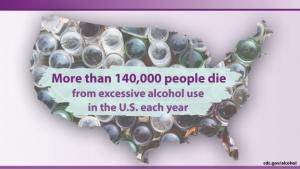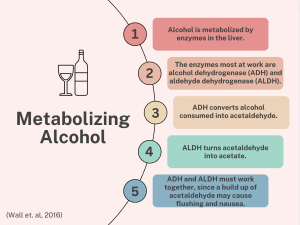2 Environmental vs. Genetic Effects Influencing Alcohol Use Disorder
Caroline Mueckler
Introduction and History
Alcohol use disorder (AUD) is a disorder where a person consumes excessive amounts of alcohol, which can lead to detrimental health problems (Edenberg & Foroud, 2013). Over the past few decades, the nature vs. nurture debate about whether AUD is due to genetics or environmental factors within a family has been prevalent. In 1947 and 1953, the first papers were published on this topic, exploring the idea of heritability for alcohol preference among humans and rats (Schuckit, 2014). In 1968, more articles were published exploring the correlation between family history of AUD and abstinence among the relatives of AUD patients. In 1973, a study on twins and adoptions reinforcing the role of genetics in AUD was published (Schuckit, 2014). From the 1970s to the 2000s, progress in genetic and environmental influences for AUD research flourished, with modern studies building on previous years examining AUD in families. However, research still needs to be done to understand the full extent of environmental vs. genetic influence (Schuckit, 2014).

Environmental Factors
In order to explain the genetic influences for AUD, the environmental factors, or the “nurture” side of the debate, must be understood, as they provide a significant basis for genetic research (Schuckit, 2014).
One such environmental factor is early life childhood stress. Stressful events in childhood, such as abuse and neglect, can be used as wide-ranging predictors of AUD in adults (Enoch, 2012). Researchers have found that stresses, more specifically called adverse childhood events, or ACEs, are associated with familial AUD and early drinking (Pilowsky et al., 2009). Furthermore, experiencing two or more ACEs, such as parental divorce or parental AUD, was associated more significantly with lifetime AUD (Pilowsky et al., 2009). Around 30-80% of people with AUD seeking treatment have experienced childhood maltreatment, with several individuals reporting that they drank alcohol to cope with trauma (Enoch, 2012). Having a parent who abused alcohol is also a risk factor for AUD (Enoch, 2012). Parental use of alcohol can create conditions where alcohol is frequently found, and drinking is more accepted in the household (Chartier et al., 2017).
Racial/ethnic minority groups are at greater risk for AUD environmental factors. This is seen in lower socioeconomic African American neighborhoods, where targeted marketing for beverages containing high amounts of alcohol is prevalent (Chartier et al., 2017). Poverty is found to be associated with more significant alcohol problems (Chartier et al., 2017). Racial discrimination can also be a stress risk factor for increased AUD among African Americans and Hispanics (Chartier et al., 2017). These factors surrounding race are essential to acknowledge and remember as the research on environmental influences on AUD continues.
Although it is clear that environmental factors exist which can cause the development of AUD, there are also protective factors. In a research study done in Sweden, individuals born between 1950 and 1980 were chosen and divided up into groups by sex, age, and socioeconomic status. These observations found that gaining a higher education, having a higher individual income, and living in a wealthier neighborhood were associated with a reduced risk for AUD in men and women of all ages (Calling et al., 2019). This study’s findings support the fact that efforts to decrease AUD risk should be focused on helping more vulnerable socioeconomic groups in adolescence (Calling et al., 2019).
Genetic Factors
Genetic influences on AUD, the “nature” side of the debate, are more novel and build upon environmental influences of AUD (Schuckit, 2014).
Longley et al. (2021) found that genetic markers account for around 50-70% of AUD risk. The fact that specific genes may increase a person’s risk for AUD means genetics may cause a person to be more predisposed to AUD. Studies surrounding adoptions have found that AUD in adopted children correlates more with AUD among their biological parents than it does among their adoptive parents, which strongly suggests genetics plays a prominent role in the development of AUD (Edenberg & Foroud, 2013). Although it is clear that genetics are at play here, it must be known that there is not one specific gene that causes a person to develop AUD, as it is hundreds of genes that work with environmental factors that will make someone more at risk (Edenberg & Foroud, 2013).

One example of how genetics may influence AUD is seen in genes involved in the metabolism of alcohol. Different forms of ADH and ALDH enzymes exist depending on a person’s genes, resulting in the metabolic rate of alcohol to vary (Wall et al., 2016). More specifically, individuals with a certain copy of the ALDH gene will cause them to flush in the face after consuming small amounts of alcohol, and will tend to experience vomiting and nausea (Edenberg & Foroud, 2013). Individuals who possess this ALDH gene may be protected from AUD, as they would experience very ill effects from consuming the slightest amounts of alcohol, so they would not likely prefer to drink alcohol frequently (Edenberg & Foroud, 2013).
Genes can also interact with environmental factors (Chartier et al., 2017). Studies have shown that environmental factors like geographical areas with high AUD rates of alcohol access, religious views, and being exposed to antisocial personality traits may work with an individual’s genetics to increase one’s risk for a dependence on alcohol (Gilbertson et al., 2008).
Conclusion and Impacts
As the research surrounding genetic and environmental influences on AUD is relatively new, more studies must be done for scientists to grasp the whole aspect of these factors’ impacts. This is important since alcohol causes about 4% of all deaths worldwide every year, and about 12.5% of Americans will meet the qualifications for alcohol dependence at some point in their life (Edenberg & Foroud, 2013). If an individual believes they may be predisposed to AUD and are concerned about their alcohol usage, they can choose to be screened for AUD. In a screening, a healthcare provider will ask questions about the frequency and quantity of alcohol being consumed (Knox et al., 2019). For an individual who screens positive for participation in harmful drinking, it is recommended to receive brief interventions that may range from advice to trained motivational interviews in order to inspire an individual to change their alcohol usage (Knox et al., 2019). If an individual screens for more severe alcohol usage, they may receive a referral for treatment (Knox et al., 2019). The first step to breaking this cycle is by educating individuals to be aware of their potential genetic or environmental predisposition to AUD to prepare for the risk of developing AUD by seeking proper treatment or care early on.
Review Questions
1. Which environmental factor was found to be associated with alcohol use disorder?
a. Child abuse
b. Parental divorce
c. Parental alcohol use disorder
d. All of the above
2. True or false: genetic markers account for around 50-70% of alcohol use disorder risk.
a. True
b. False
3. What is the most likely cause of an individual developing alcohol use disorder?
a. Only genetic factors
b. Only environmental factors
c. A mixture of genetic and environmental factors
d. None of the above
References
Calling, S., Ohlsson, H., Sundquist, J., Sundquist, K., & Kendler, K.S. (2019). Socioeconomic status and alcohol use disorders across the lifespan: A co-relative control study. PLoS ONE, 14(10). doi: 10.1371/journal.pone.0224127.
Chartier, K. G., Karriker-Jaffe, K. J., Cummings, C. R., & Kendler, K. S. (2017). Review: Environmental influences on alcohol use: Informing research on the joint effects of genes and the environment in diverse U.S. populations. The American Journal on Addictions, 26(5): 446-460. doi: 10.1111/ajad.12478.
Edenberg, H. J., & Foroud, T. (2013). Genetics and alcoholism. Nature Reviews Gastroenterology & Hepatology, 10(8):487-94. doi: 10.1038/nrgastro.2013.86.
Enoch, M.A. (2012, April). The influence of gene-environment interactions on the development of alcoholism and drug dependence. Current Psychiatry Reports, 14(2):150-8. doi: 10.1007/s11920-011-0252-9.
Gilbertson, R., Prather, R., & Nixon, S.J. (2008). The role of selected factors in the development and consequences of alcohol dependence. Alcohol Research & Health, 31(4):389-99. https://www.ncbi.nlm.nih.gov/pmc/articles/PMC3860467/.
Knox, J., Hasin, D.S., Larson, F.R.R., & Kranzler, H.R. (2019, December). Prevention, screening, and treatment for heavy drinking and alcohol use disorder. The Lancet Psychiatry, 6(12):1054-1067. doi: 10.1016/S2215-0366(19)30213-5.
Longley, M.J., Lee, J., Jung, J., & Lohoff, F.W. (2021, November). Epigentics of alcohol use disorder- A review of recent advances in DNA methylation profiling. Addiction Biology,26(6):e13006. doi: 10.1111/adb.13006.
Pilowsky, D.J., Keyes K.M., & Hasin, D.S. (2009, February). Adverse childhood events and lifetime alcohol dependence. American Journal of Public Health, 99(2):258-63. doi: 10.2105/AJPH.2008.139006.
Schuckit, M.A. (2014, March). A brief history of research on the genetics of alcohol and other drug use disorders. Journal of Studies on Alcohol and Drugs Supplement, 75 Suppl 17(Suppl 17): 59-67. https://www.ncbi.nlm.nih.gov/pmc/articles/PMC4453498/.
Wall, T.L., Luczak, S.E., & Hiller-Strumhöfel, S. (2016). Biology, Genetics, and Environment: Underlying Factors Influencing Alcohol Metabolism. Alcohol Research: Current Reviews, 38(1):59-68. https://pubmed.ncbi.nlm.nih.gov/27163368/.
a medical condition characterized by an impaired ability to stop or control alcohol use despite its negative impact on their life
the proportion of observed variation in a particular trait (such as height) that can be attributed to inherited genetic factors in contrast to environmental ones
the practice of not doing or having something that is wanted or enjoyable
traumatic events that occur before a child reaches the age of 18, such as domestic violence, abuse, and neglect
cruel, rough, or violent treatment; abuse
a disordered psychic or behavioral state resulting from severe mental or emotional stress or physical injury
of, relating to, or involving a combination of social and economic factors
unjust or prejudicial treatment or views of different people based on ethnicity, age, sex, or disability
the phase of life from ages 10 to 19 where a child develops into a young adult
a recognizable segment of DNA used for the identification of a trait
to have an increased chance of having a certain attitude, behavior, or condition; make susceptible
the breakdown of chemical substances; the sum of processes that provide the body with energy
an enzyme found in the liver that metabolizes or breaks down alcohol
enzymes that are involved in the metabolism or further breakdown of alcohol after alcohol dehydrogenase (ADH)
a tinge of red; blush
averse to the society of others; unsociable

